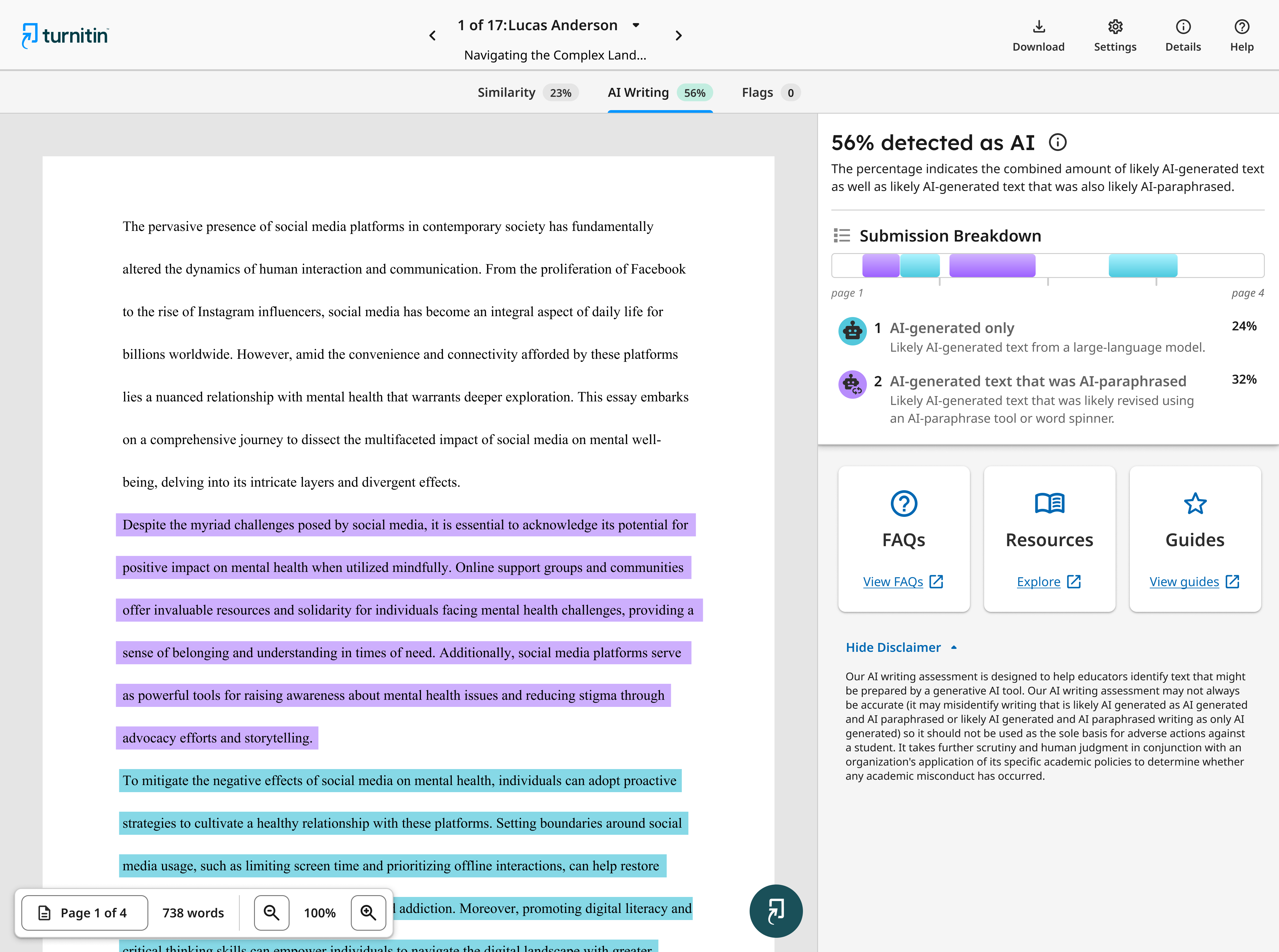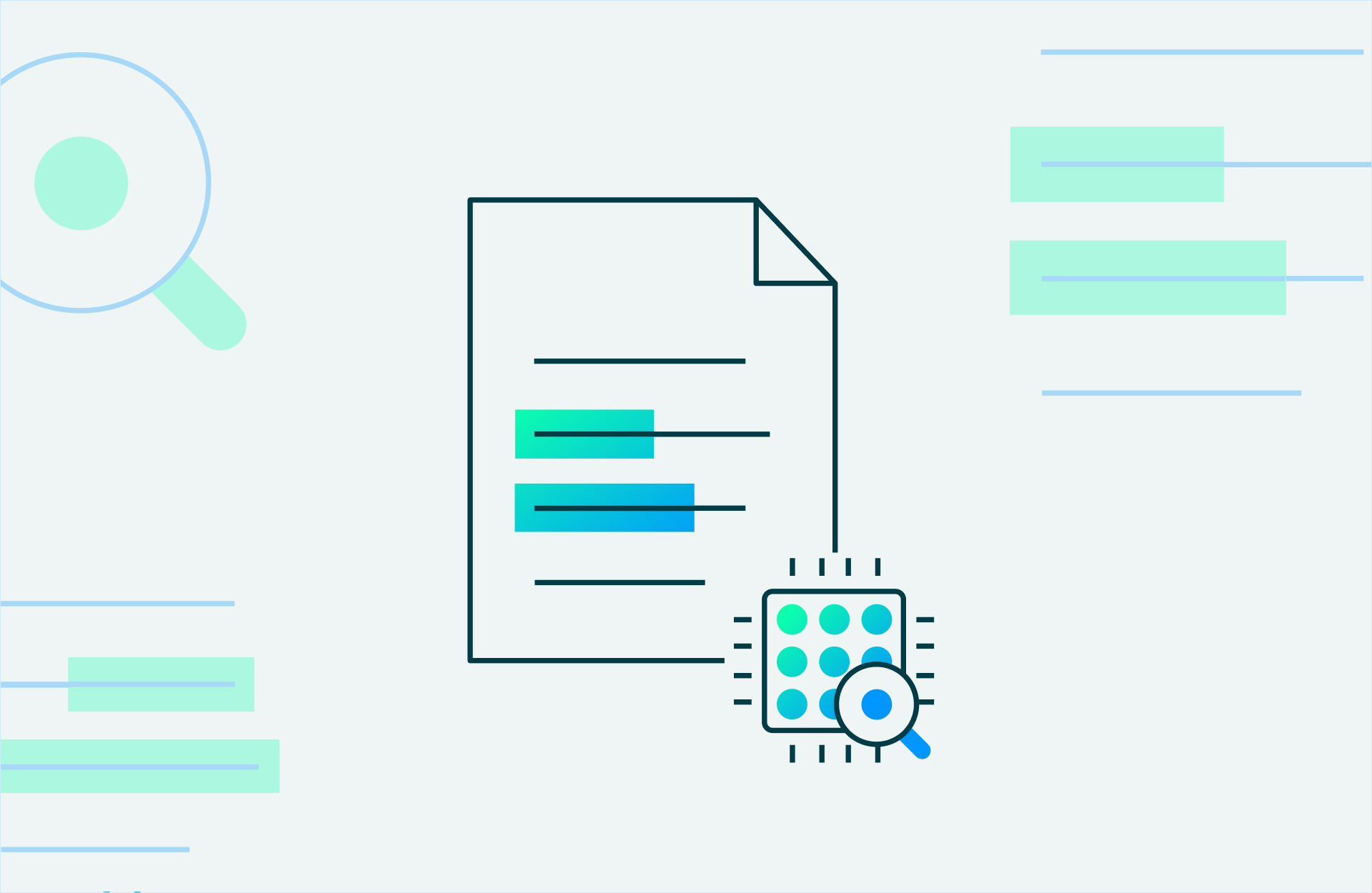In the rapidly evolving landscape of academic writing, maintaining integrity is paramount. With the proliferation of AI tools, ensuring originality in submitted content has become increasingly challenging.
In early 2023, Turnitin launched its AI writing indicator and report, leveraging over 25 years of experience in understanding and safeguarding academic writing. Our technology helps create transparency that aids instructors in discerning likely AI-generated content from human-written work. However, the increase of AI paraphrasing tools poses a fresh challenge to academic integrity, prompting institutions to seek proactive measures .
To address this emerging issue, Turnitin is pleased to announce the launch of its new AI paraphrasing detection feature, expanding on the capabilities of our AI writing indicator.
Join us as we uncover Turnitin’s role in advancing student learning, upholding academic standards in both education and research writing, and supporting the academic community as they strive to safeguard their output in the age of AI.
What is AI paraphrasing?
Paraphrasing is the practice of rephrasing or restating someone else's ideas or information using your own words and sentence structures. It is a common technique used in academic writing to present information in a more concise or understandable way while still attributing the original source. Paraphrasing requires a deep understanding of the content and the ability to express it in a new form without changing the original meaning.
On the other hand, AI paraphrasing refers to the process of using AI technology to rewrite text while retaining the original meaning. These AI-powered tools, also known as text spinners, analyze the input text and generate alternative versions that convey the same information using different words or sentence structures.
The ease of access to these tools has raised concerns about academic integrity. Students and researchers may use AI paraphrasing to modify AI-generated content, such as that produced by language models like ChatGPT, in an attempt to evade detection by AI detection software.
How is AI paraphrasing impacting academic integrity?
AI paraphrasing poses a significant risk to academic integrity in that it erodes the principles of academic integrity by promoting deception and dishonesty. It undermines the trust and credibility of educational institutions and devalues the importance of original thought and scholarly discourse.
Masking AI-generated text to evade detection
Writers, including students and researchers, may use AI paraphrasing to modify AI-generated content, making it difficult for AI writing detection software to identify instances of AI-generated text. This practice effectively disguises the source of their content, being a large language model, leading educators and publishers to believe that the work is original.
Shortcut to writing skills
Relying on an AI paraphrasing tool deprives students of the opportunity to develop their writing skills authentically. Instead of engaging in critical thinking and original expression, students may resort to automated solutions, hindering their intellectual growth and academic development. By bypassing the process of crafting original content, students miss out on valuable learning experiences that foster creativity, analytical thinking, and effective communication skills.
How can Turnitin’s new AI paraphrasing detection tool help to uphold academic integrity?
A study conducted by Odri and Yun Yoon ( 2023 ) reveals that while their text sample was written solely by generative AI, seven out of eleven AI writing detection tools (excluding Turnitin) concluded that the text was mainly written by humans. The widespread availability of online text spinners and AI paraphrasing tools has made it easy for writers to manipulate content, which in turn, may not be flagged by AI writing detection tools.
Turnitin's AI paraphrasing detection feature seeks to address this issue by identifying instances where AI paraphrasing may have been used to modify AI-generated text in submitted content, helping publishers and educators to maintain the integrity of research writing and foster authentic learning experiences for students.
Data insights to determine your next course of action
The AI writing report highlights the text segments that our model predicts were likely written by an AI tool. It also highlights AI-generated text that may have been further modified using an AI paraphrasing tool. Assessors can use the data and insights provided by our tool to start a discussion. In the education space, educators can use potential misconduct issues as teachable moments to help students improve their writing skills while developing their critical thinking abilities .
Both AI writing and AI paraphrasing segments are highlighted in different colors to enable educators and other users to interpret results easily. The highlight bar on the right-side of the report further shows the breakdown of content in percentage terms that was likely AI-generated and content that may have been AI-generated or AI-paraphrased.
Integrated into your workflow via the Similarity Report
Turnitin’s AI writing detection capabilities are fully integrated into the Similarity Report, providing our users with a seamless experience. When AI writing detection is enabled, which also includes AI paraphrasing detection, it automatically checks every submission for both AI writing and AI paraphrasing. It shows an overall percentage of the document that was likely AI-generated and an additional score for likely AI generated content that may also have been AI paraphrased. Your AI detection needs sit under one safe, secure, and easily accessible umbrella.

More than just detection
Just as speed cameras discourage drivers from exceeding the speed limit, Turnitin's AI paraphrasing detection acts as a deterrent for students and researchers tempted to misuse AI writing tools, serving as a powerful incentive for upholding academic integrity and engaging in ethical writing and paraphrasing practices.
By integrating AI paraphrasing detection into the submission process, Turnitin provides educators and publishers with a proactive tool to prevent misconduct before it occurs, thus reinforcing academic integrity and ethical writing practices. AI paraphrasing detection allows instructors to initiate constructive conversations with students about the importance of ethical writing practices and the proper use of paraphrasing techniques.
A tool for human interpretation
Turnitin does not make a determination of misconduct; rather, it provides data for the educators to make an informed decision based on their academic and institutional policies.
Roe and Perkins ( 2022 ) argue that, by relying solely on technical solutions to combat the misuse of AI paraphrasing tools, this may lead to an ongoing arms race. Instead, they advocate for prioritizing training as the most effective strategy for reducing students' use of these tools and enhancing faculty members' ability to detect such usage.
With this in mind, we must emphasize that the data surfaced by our tool should not be used as the sole basis for action or a definitive grading measure by instructors. The information should be used as a data point and can be the first step toward starting a discussion with students and researchers.
How will the release of AI paraphrasing detection impact Turnitin customers?
Customers who license Turnitin Originality with their existing Turnitin integrity solution, and have Turnitin’s AI writing detection capabilities enabled, will gain full access to AI paraphrasing detection as part of their license. iThenticate customers that license Turnitin’s AI writing detection capabilities will also have access to AI paraphrasing detection as part of their license. These capabilities are seamlessly integrated into Turnitin's existing AI writing detection workflow, ensuring no change in the way instructors utilize these tools.
As part of the AI writing detection process, AI paraphrasing detection results will be surfaced within the AI writing report, which is integrated with the Similarity Report and customers' learning management systems (LMS). This ensures that for those with access to the Turnitin AI writing indicator, AI paraphrasing detection will run automatically on every submission. This eliminates the need for additional software or workflows, improving efficiency for our time-strapped customers.
With this integration, there will be no change in workflow. If enabled, instructors will be able to check all submissions for AI writing and AI paraphrasing simultaneously.
Administrators have the flexibility to choose whether or not to enable access to AI writing and AI paraphrasing detection capabilities from their admin settings page for their instructors.
Overview: Strengthening academic writing with AI paraphrasing detection
The proliferation of AI paraphrasing tools to avoid AI detection presents yet another challenge to academic integrity so soon after the launch of generative AI in 2022. Students and researchers who use these tools to evade detection by modifying AI-generated text undermines the credibility of assessments and research.
To address this issue, it's essential for educators to emphasize the importance of originality and critical thinking in academic writing. This can be achieved through educational initiatives that promote proper paraphrasing techniques and discourage reliance on automated solutions. Additionally, institutions can foster a culture of academic honesty by implementing clear guidelines and consequences for plagiarism .
Ultimately, by prioritizing authentic learning experiences and providing support for students to develop their writing skills, we can help mitigate the impact of AI paraphrasing on academic integrity and uphold the standards of scholarly discourse.




